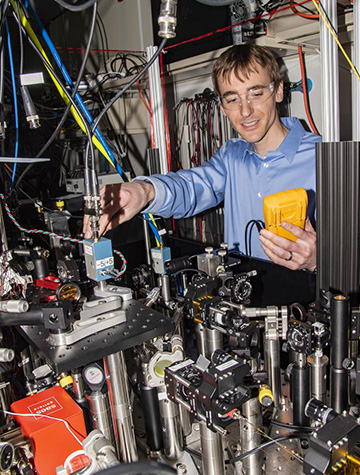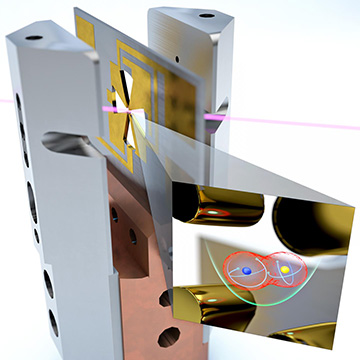A detail view of the ion trap (gold structure with cross-shaped cutout) used in the new NIST quantum logic clock. The clock works by using a laser-cooled magnesium ion (yellow) to sympathetically cool the trapped aluminum ion (blue), whose hyper-precise “ticks” are read out through quantum logic spectroscopy from the partner magnesium ion. [Image: S. Burrows/JILA] [Enlarge image]
Researchers at the National Institute of Standards and Technology (NIST), USA, have unveiled a new instance of the group’s single-ion “quantum logic clock” that has demonstrated the lowest systematic frequency uncertainty, and thus the highest precision, of any clock yet shown—a stunning 9.4×10–19 (Phys. Rev. Lett., doi: 10.1103/PhysRevLett.123.033201).
The new clock’s performance in the other big figure of merit, clock stability, still falls about an order of magnitude short of that of the best optical lattice clocks. The team believes, however, that the new clock’s matchless precision opens up opportunities for improved measurements and tests of fundamental physics—and the researchers are hard at work pushing it to even greater heights.
The problem with 27Al+
Single-ion clocks use radio-frequency electric fields to trap a laser-cooled ion, and then interrogate the ion’s electronic transitions with an ultrastable narrowband laser. The German–American physicist (and future Nobel laureate) Hans Dehmelt first suggested some three and one-half decades ago that such trapped oscillating ions could form a peerless frequency standard.
Dehmelt also zeroed in on one ion, 27Al+, as a particularly strong candidate for such an ion clock, by virtue of the very small linewidth in its well-defined, high-frequency 1S0 ↔ 3P0 optical transition and by its resistance to noise sources such as blackbody radiation. But 27Al+ also turns out to be difficult to cool and interrogate with lasers, as the optical transition for both functions in the ion lies in the vacuum UV, a tough lift for today’s laser technology.
The go-between
In 2005, a NIST team led by future Nobel laureate and OSA Honorary Member David Wineland found a way to overcome these disadvantages and access the 27Al+ trapped-ion system—by using another ion, 9Be+, as a sort of go-between. In the scheme, known as quantum logic spectroscopy, the partner ion—referred to as the logic ion—is the one that’s laser cooled. That ion then “sympathetically” cools the nearby 27Al+ in the RF ion trap through Coulomb interactions. The same interactions can be used to grab onto the internal state of the 27Al+ ion, which can be read out from the logic ion at accessible laser frequencies and interpreted probabilistically using quantum logic protocols.
By 2010, NIST’s quantum logic clock—using a magnesium rather than a beryllium ion as the go-between—achieved a systematic uncertainty of 8.6×10–18—precise enough to detect the time dilation predicted by special relativity with a change in height of only 33 centimeters, equivalent to a few steps on an ordinary staircase. Since then, however, another breed of clock—so-called optical-lattice clocks, which work by laser interrogation of ensembles of atoms trapped in optical standing waves—have very slightly surpassed that earlier precision record (see “Toward the Optical Second,” OPN, February 2019).
Driving down thermal and trap noise

David Leibrandt at NIST led the team behind work to improve the precision of the quantum logic clock. [Image: Burrus/NIST]
The NIST team behind the new work, which includes Wineland and is led by David Leibrandt, has now put the quantum logic clock back on top in the optical-clock precision race. The researchers did so through a new trap design that allowed them to minimize the thermal noise of the two trapped ions, and to dial back the required voltages and RF fields that added micromotions that could gum up the signal from the 27Al+ ion.
The resulting uncertainty measurement, 9.4×10–19, means, in the words of a NIST press release, that the clock “would neither gain nor lose one second in 33 billion years,” more than twice the age of the known universe. The clock also sports a stability (basically a measure of how long it takes for the clock to make a measurement) that’s in line with the best trapped-ion clocks reported to date—though it’s about ten times less stable than the best optical-lattice clocks, some of which have also been developed at NIST.
A new number to beat
NIST is at pains to stress, however, that notwithstanding the appearance of a competition, all of these types of hyper-precise clocks have their place, and all are enabling advances in exquisitely fine measurements of Earth’s surface gravity, in navigation and in tests of fundamental physics—as well as opening a possible path for redefining the SI second.
That said, the new NIST quantum logic clock has clearly shifted at least the psychological benchmark on precision for future clocks from 10–18 to 10–19. And the team behind the pathbreaking clock sees the potential to drive its precision still further, through “improvements in trap design, uncertainty in the static differential polarizability, and background gas pressure.”

